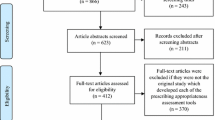Abstract
Background Medication review is important in an era, in which polypharmacy is increasing. To date, no agreed international definition of medication review exists. Objective The aim was to reach agreement on an internationally applicable definition of medication review. Setting An international group of experts in medication review. Methods A working group of the Pharmaceutical Care Network Europe (PCNE) was established to agree on a definition including a classification of medication review. First, a survey with the aim of systematically gathering viewpoints on a definition of medication review was conducted. Second, a workshop was held to achieve an agreement. Finally, during the General Assembly of PCNE, the definition was approved. To ensure a better understanding of the scope and the considerations behind the definition, a position paper was created. Main outcome measure An internationally agreed definition of medication review. Results 58 PCNE members from 20 different countries completed the online survey. Then, 22 participants from 11 different countries (not only PCNE members) elaborated the final definition during a workshop. The final PCNE version agreed was: “Medication review is a structured evaluation of a patient’s medicines with the aim of optimising medicines use and improving health outcomes. This entails detecting drug-related problems and recommending interventions”. Overall, the consensus process included 225 people from 35 countries and resulted also in a classification of medication review taking into account the type and source of available information. Conclusion Involvement of an international community from research and practice and the use of a systematic process led to an agreement on the term medication review and on a classification valid for all settings and professions.





Similar content being viewed by others
References
Ernst FR, Grizzle AJ. Drug-related morbidity and mortality: updating the cost-of-illness model. J Am Pharm Assoc (Wash). 2001;41:192–9.
World Health Organization (WHO). Medication without harm: WHO’s third global patient safety challenge. http://www.who.int/en/news-room/detail/29-03-2017-who-launches-global-effort-to-halve-medication-related-errors-in-5-years. Accessed 10 May 2018.
van Mil JWF, Westerlund T, Brown L, Chen TF, Henman M, Hersberger KE, et al. Medical care and drug-related problems: Do doctors and pharmacists speak the same language? Int J Clin Pharm. 2016;38:191–4.
Hepler CD, Strand LM. Opportunities and responsibilities in pharmaceutical care. Am J Hosp Pharm. 1990;47:533–43.
Zermansky AG. Who controls repeats? Br J Gen Pract. 1996;46:643–7.
Christen C. Clinical pharmacy and medication safety. Ann Pharmacother. 2006;40:2020–1.
Whitney HAK, Nahata MC, Thordsen DJ. Francke’s legacy—40 years of clinical pharmacy. Ann Pharmacother. 2008;42:121–6.
Wijsman R. Effectieve medicatiebewaking in de apotheek. [Effective medication surveillance in the pharmacy]. Pharm Weekbl. 1975;110:1245–6.
Bulajeva A, Labberton L, Leikola S, Pohjanoksa-Mäntylä M, Geurts MME, de Gier JJ, Airaksinen M. Medication review practices in European countries. Res Soc Adm Pharm. 2014;10:731–40.
Blenkinsopp A, Bond C, Raynor DK. Medication reviews. Br J Clin Pharmacol. 2012;74:573–80.
Tully MP, Seston EM. Impact of pharmacists providing a prescription review and monitoring service in ambulatory care or community practice. Ann Pharmacother. 2000;34:1320–31.
Holland R, Desborough J, Goodyer L, Hall S, Wright D, Loke YK. Does pharmacist-led medication review help to reduce hospital admissions and deaths in older people? A systematic review and meta-analysis. Br J Clin Pharmacol. 2008;65:303–16.
Shaw J, Seal R, Pilling M. Room for review. 2002. http://myweb.tiscali.co.uk/bedpgme/CG/Room%20for%20Review%20-%20Medication%20review.pdf. Accessed 11 May 2018.
Messerli M, Blozik E, Vriends N, Hersberger KE. Impact of a community pharmacist-led medication review on medicines use in patients on polypharmacy—a prospective randomised controlled trial. BMC Health Serv Res. 2016;16:145.
Leikola S, van Mil JWF. PCNE medication review types and problems that can be detected. http://www.pcne.org/upload/wc2013/Workshops/WS%201%20PCNE%20Types%20and%20Problems.pdf. Accessed 11 May 2018.
Leikola S, van Mil JWF. Overview: what activities are part of the different PCNE types of medication review. http://www.pcne.org/upload/wc2013/Workshops/WS%201%20PCNE%20Types%20and%20Activities.pdf. Accessed 11 May 2018.
Priest H, Roberts P, Woods L. An overview of three different approaches to the interpretation of qualitative data. Part 1: theoretical issues. Nurse Res. 2002;10:30–42.
Hersberger KE, Griese-Mammen N, Kos M, Horvat N, Messerli M, van Mil JWF. Position paper on the PCNE definition of medication review. 04.2016. http://www.pcne.org/upload/files/149_Position_Paper_on_PCNE_Medication_Review_final.pdf. Accessed 11 May 2018.
Black N, Murphy M, Lamping D, McKee M, Sanderson C, Askham J, Marteau T. Consensus development methods: a review of best practice in creating clinical guidelines. J Health Serv Res Policy. 1999;4:236–48.
World Health Organization (WHO). Action on patient safety (High5s)—assuring medication accuracy at transitions of care: medication reconciliation. 2014. http://www.who.int/patientsafety/implementation/solutions/high5s/h5s-sop.pdf. Accessed 11 May 2018.
Allemann SS, van Mil JWF, Botermann L, Berger K, Griese N, Hersberger KE. Pharmaceutical care: the PCNE definition 2013. Int J Clin Pharm. 2014;36:544–55.
van Mil JWF, McElnay J, de Jong-van Den Berg LTW, Tromp FJ. The challenges of defining pharmaceutical care on an international level. Int J Pharm Pract. 1999;7:202–8.
Acknowledgements
We thank all participants of the discussions and the online survey for making this agreement on the term medication review and on the classification possible. Furthermore, we are grateful to Prof. Martin Henman (Trinity College Dublin, Ireland) for editing the final draft and to Christian Rutschmann (Business Images AG, Switzerland) for his support as a graphic designer.
Funding
No special funding was received for this paper or the processes described herein.
Conflicts of interest
The authors have no conflicts of interest in connection with this article.
Author information
Authors and Affiliations
Corresponding author
Rights and permissions
About this article
Cite this article
Griese-Mammen, N., Hersberger, K.E., Messerli, M. et al. PCNE definition of medication review: reaching agreement. Int J Clin Pharm 40, 1199–1208 (2018). https://doi.org/10.1007/s11096-018-0696-7
Received:
Accepted:
Published:
Issue Date:
DOI: https://doi.org/10.1007/s11096-018-0696-7




